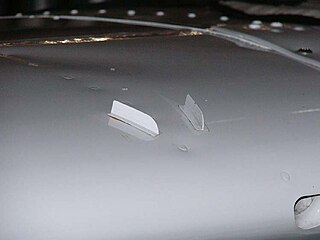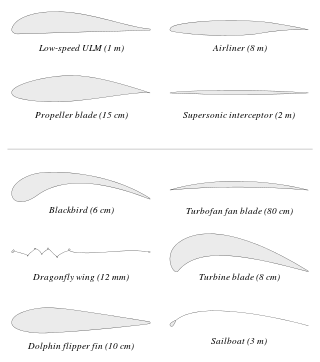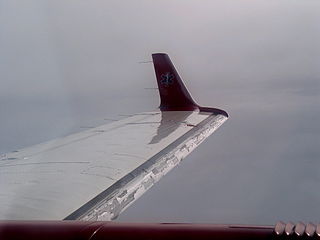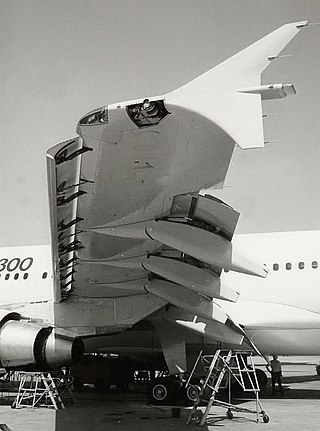
A turbulator is a device that turns a laminar boundary layer into a turbulent boundary layer.

A turbulator is a device that turns a laminar boundary layer into a turbulent boundary layer.
Turbulent flow can be desired on parts of the surface of an aircraft wing (airfoil) or in industrial applications such as heat exchangers and the mixing of fluids. The term “turbulator” is applied to a variety of applications and is used as a derivative of the word turbulent. However, the word has no commonly accepted technical or scientific meaning. It has been approved as a trademark in the U.S. and other countries in conjunction with machine parts used within rotating drums, sterilizers, heat transfer ovens, mixing and pelletizing machines, and air destratification fans for horticultural and agricultural uses, among others.
In gliders the turbulator is often a thin zig-zag strip that is placed on the lower side of the wing and sometimes on the vertical stabilizer. [1]

In wind sensors (anemometers), the use of turbulators reduces inaccuracies in the measurement of wind speed caused by the unpredictable switching between laminar flow and turbulent flow. Therefore the calibration of the wind sensor can be accomplished more accurately. Since wind direction can be calculated from a number of wind speed measurements, the measurement of the wind direction is also improved. [2]

In physics, physical chemistry and engineering, fluid dynamics is a subdiscipline of fluid mechanics that describes the flow of fluids—liquids and gases. It has several subdisciplines, including aerodynamics and hydrodynamics. Fluid dynamics has a wide range of applications, including calculating forces and moments on aircraft, determining the mass flow rate of petroleum through pipelines, predicting weather patterns, understanding nebulae in interstellar space and modelling fission weapon detonation.

In fluid dynamics, laminar flow is characterized by fluid particles following smooth paths in layers, with each layer moving smoothly past the adjacent layers with little or no mixing. At low velocities, the fluid tends to flow without lateral mixing, and adjacent layers slide past one another like playing cards. There are no cross-currents perpendicular to the direction of flow, nor eddies or swirls of fluids. In laminar flow, the motion of the particles of the fluid is very orderly with particles close to a solid surface moving in straight lines parallel to that surface. Laminar flow is a flow regime characterized by high momentum diffusion and low momentum convection.

A wing is a type of fin that produces lift while moving through air or some other fluid. Accordingly, wings have streamlined cross-sections that are subject to aerodynamic forces and act as airfoils. A wing's aerodynamic efficiency is expressed as its lift-to-drag ratio. The lift a wing generates at a given speed and angle of attack can be one to two orders of magnitude greater than the total drag on the wing. A high lift-to-drag ratio requires a significantly smaller thrust to propel the wings through the air at sufficient lift.

Wind tunnels are large tubes with air blowing through them which are used to replicate the interaction between air and an object flying through the air or moving along the ground. Researchers use wind tunnels to learn more about how an aircraft will fly. NASA uses wind tunnels to test scale models of aircraft and spacecraft. Some wind tunnels are large enough to contain full-size versions of vehicles. The wind tunnel moves air around an object, making it seem as if the object is flying.

In fluid dynamics, the drag coefficient is a dimensionless quantity that is used to quantify the drag or resistance of an object in a fluid environment, such as air or water. It is used in the drag equation in which a lower drag coefficient indicates the object will have less aerodynamic or hydrodynamic drag. The drag coefficient is always associated with a particular surface area.

The Coandă effect is the tendency of a fluid jet to stay attached to a convex surface. Merriam-Webster describes it as "the tendency of a jet of fluid emerging from an orifice to follow an adjacent flat or curved surface and to entrain fluid from the surroundings so that a region of lower pressure develops."

In physics and fluid mechanics, a boundary layer is the thin layer of fluid in the immediate vicinity of a bounding surface formed by the fluid flowing along the surface. The fluid's interaction with the wall induces a no-slip boundary condition. The flow velocity then monotonically increases above the surface until it returns to the bulk flow velocity. The thin layer consisting of fluid whose velocity has not yet returned to the bulk flow velocity is called the velocity boundary layer.

A vortex generator (VG) is an aerodynamic device, consisting of a small vane usually attached to a lifting surface or a rotor blade of a wind turbine. VGs may also be attached to some part of an aerodynamic vehicle such as an aircraft fuselage or a car. When the airfoil or the body is in motion relative to the air, the VG creates a vortex, which, by removing some part of the slow-moving boundary layer in contact with the airfoil surface, delays local flow separation and aerodynamic stalling, thereby improving the effectiveness of wings and control surfaces, such as flaps, elevators, ailerons, and rudders.

An airfoil or aerofoil is a streamlined body that is capable of generating significantly more lift than drag. Wings, sails and propeller blades are examples of airfoils. Foils of similar function designed with water as the working fluid are called hydrofoils.

Parasitic drag, also known as profile drag, is a type of aerodynamic drag that acts on any object when the object is moving through a fluid. Parasitic drag is a combination of form drag and skin friction drag. It affects all objects regardless of whether they are capable of generating lift.

In aviation, icing conditions are atmospheric conditions that can lead to the formation of water ice on an aircraft. Ice accretion and accumulation can affect the external surfaces of an aircraft – in which case it is referred to as airframe icing – or the engine, resulting in carburetor icing, air inlet icing or more generically engine icing. These phenomena may possibly but do not necessarily occur together. Both airframe and engine icing have resulted in numerous fatal accidents in aviation history.
Boundary layer control refers to methods of controlling the behaviour of fluid flow boundary layers.

In fluid dynamics, flow separation or boundary layer separation is the detachment of a boundary layer from a surface into a wake.
Boundary layer suction is a boundary layer control technique in which an air pump is used to extract the boundary layer at the wing or the inlet of an aircraft. Improving the air flow can reduce drag. Improvements in fuel efficiency have been estimated as high as 30%.

Peter C. Masak was an engineer, inventor, and glider pilot. He graduated with a Bachelor of Applied Science degree in mechanical engineering in May 1981 from the University of Waterloo, Ontario, Canada. He earned his glider pilot license at the age of 16 and his power pilot license at the age of 18, the minimum ages for both. Peter was a Canadian soaring record holder and represented Canada and later the United States in the World Gliding Championships. He logged almost 2000 hours of glider flight time. He was living in West Chester, Pennsylvania with his wife Adrienne and their three children when he died.

Slats are aerodynamic surfaces on the leading edge of the wing of a fixed-wing aircraft which, when deployed, allow the wing to operate at a higher angle of attack. A higher coefficient of lift is produced as a result of angle of attack and speed, so by deploying slats an aircraft can fly at slower speeds, or take off and land in shorter distances. They are used during takeoff and landing or while performing low speed maneuvers which may take the aircraft close to a stall. Slats are retracted in normal flight to minimize drag.

In fluid mechanics, the Reynolds number is a dimensionless quantity that helps predict fluid flow patterns in different situations by measuring the ratio between inertial and viscous forces. At low Reynolds numbers, flows tend to be dominated by laminar (sheet-like) flow, while at high Reynolds numbers, flows tend to be turbulent. The turbulence results from differences in the fluid's speed and direction, which may sometimes intersect or even move counter to the overall direction of the flow. These eddy currents begin to churn the flow, using up energy in the process, which for liquids increases the chances of cavitation.
Airflow, or air flow, is the movement of air. The primary cause of airflow is the existence of air. Air behaves in a fluid manner, meaning particles naturally flow from areas of higher pressure to those where the pressure is lower. Atmospheric air pressure is directly related to altitude, temperature, and composition.

Flow control is a field of fluid dynamics. It involves a small configuration change to serve an ideally large engineering benefit, like drag reduction, lift increase, mixing enhancement or noise reduction. This change may be accomplished by passive or active devices.

The serpentine plasma actuator represents a broad class of plasma actuator. The actuators vary from the standard type in that their electrode geometry has been modified in to be periodic across its span.